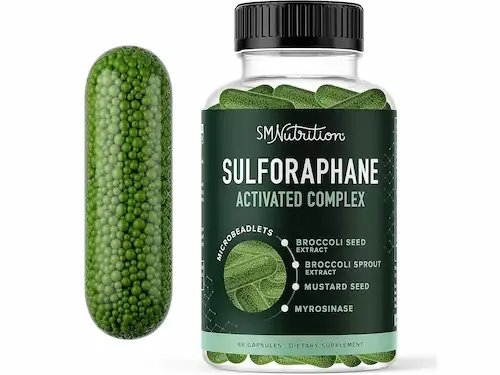Introduction
Autism is a complex neurodevelopmental disorder characterized by impaired social interaction, communication difficulties, and restricted and repetitive patterns of behavior. While the exact cause of autism remains unknown, researchers have made significant progress in understanding the underlying mechanisms and identifying potential remedies. One such remedy that has shown remarkable promise is sulforaphane, a chemical compound found in broccoli sprouts and other cruciferous vegetables. In this article, we will delve into the powerful effects of sulforaphane in alleviating autism symptoms and explore its potential as a low-cost and low-toxicity treatment option.
The Benefits of Sulforaphane
Sulforaphane has been the subject of extensive research due to its diverse range of benefits. Not only has it been found to have antimicrobial properties, including the ability to kill off H. pylori bacteria associated with stomach ulcers, but it has also demonstrated a profound effect on inhibiting various viruses, including HIV, hepatitis C, and hepatitis B. However, one study in particular has highlighted its potential in treating autism, with a significant 65% improvement in autistic symptoms observed. This improvement was especially notable in relation to social responses, making sulforaphane a promising remedy for individuals with autism.
Understanding Autism and Oxidative Stress
To comprehend the impact of sulforaphane on autism symptoms, it is essential to first understand the underlying conditions associated with autism. Individuals with autism often exhibit low antioxidant capacity and heightened oxidative stress in the brain. Oxidative stress refers to an imbalance between antioxidants, which protect cells from damage, and oxidation, which can cause harm. One key antioxidant that is often depleted in individuals with autism is glutathione, which plays a crucial role in combating oxidative stress.
The Role of Glutathione in Autism
Glutathione is a vital antioxidant produced by the body that helps maintain optimal cellular function. However, in individuals with autism, glutathione levels are significantly reduced. This depletion can be attributed to various factors, including the human immunodeficiency virus (HIV), which has the ability to disrupt glutathione production and deplete essential materials needed for its synthesis. As a result, the immune system becomes compromised, rendering it unable to effectively combat infections and oxidative stress. This depletion of glutathione has been linked to a range of health problems, including COPD, Alzheimer's disease, Parkinson's disease, cancer, autoimmune diseases, ADHD, bipolar disorder, schizophrenia, and even autism.
Activating the Nrf2 Protein for Antioxidant Defense
The Nrf2 protein serves as the master regulator of the body's antioxidant defense system. It activates and upregulates the production of various antioxidants, including glutathione, superoxide dismutase (SOD), and catalase. Additionally, Nrf2 activates detoxification enzymes and plays a crucial role in regulating the T helper cell of the immune system. By activating and enhancing the function of Nrf2, sulforaphane and other compounds can effectively reduce oxidative stress and alleviate autism symptoms.
Inhibitors of Nrf2 Activation
Several factors can inhibit the activation of the Nrf2 protein, thereby hindering the body's ability to combat oxidative stress and alleviate autism symptoms. High-sugar diets, insulin resistance, lack of sleep, stress, glyphosate (a common herbicide), soy and corn-fed to animals, alcohol, smoking, toxins, medications, and infections can all impede Nrf2 activation. Additionally, certain genetic alterations can make it challenging to upregulate Nrf2, underscoring the importance of understanding one's genetic predispositions and taking appropriate measures to enhance antioxidant defense.
Activators of Nrf2 and Enhancing the Antioxidant Network
On the other hand, several compounds and lifestyle factors can activate and enhance the Nrf2 protein, thereby bolstering the body's antioxidant network and reducing autism symptoms. Sulforaphane, found abundantly in cruciferous vegetables such as broccoli sprouts and broccoli microgreens, is a powerful activator of Nrf2. Other compounds that can trigger Nrf2 activation include selenium, cysteine, glutamine, tryptophan, and N-acetyl cysteine (NAC). Prolonged fasting, sulfur-rich vegetables like garlic and onion, alpha-lipoic acid, essential vitamins and minerals (vitamin A, vitamin C, vitamin D, vitamin E, zinc, and selenium), milk thistle, regular exercise, and green tea phytonutrients also contribute to the activation of Nrf2 and the enhancement of the body's antioxidant defense.
The Role of the Gut Microbiome in Autism
In recent years, researchers have increasingly recognized the role of the gut microbiome in various health conditions, including autism. The gut microbiome consists of trillions of microorganisms that reside in the gastrointestinal tract and play a crucial role in digestion, nutrient absorption, immune function, and overall health. Studies have shown that individuals with autism often have imbalances in their gut microbiome, with reduced microbial diversity and altered composition. Restoring a healthy and diverse gut microbiome can not only enhance the activation of Nrf2 but also promote the production of antioxidants and secondary chemicals that combat oxidative stress.
A Holistic Approach to Autism Treatment
Understanding the powerful effects of sulforaphane and its ability to activate the Nrf2 protein provides a foundation for a holistic approach to treating autism. By incorporating a diet rich in cruciferous vegetables, along with other foods and lifestyle factors that enhance Nrf2 activation, individuals with autism can potentially alleviate their symptoms and improve their overall well-being. Additionally, addressing the gut microbiome through dietary interventions and probiotic supplementation can further enhance the body's antioxidant network and promote optimal health.
Conclusion
Sulforaphane, a powerful compound found in broccoli sprouts and other cruciferous vegetables, holds significant promise in treating autism symptoms. By activating the Nrf2 protein and enhancing the body's antioxidant defense, sulforaphane can effectively reduce oxidative stress and improve various aspects of autism, particularly those related to social responses. Incorporating sulforaphane-rich foods into the diet, along with other lifestyle factors that enhance Nrf2 activation and promote a healthy gut microbiome, can offer individuals with autism a natural and low-toxicity approach to managing their condition. As research continues to uncover the intricate mechanisms behind autism and the role of antioxidants, the potential for further advancements in treatment options grows, offering hope for a brighter future for individuals with autism and their families.

